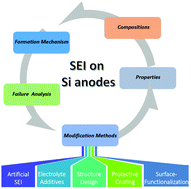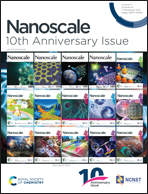Designing superior solid electrolyte interfaces on silicon anodes for high-performance lithium-ion batteries
Abstract
The solid electrolyte interface (SEI) is a passivation layer formed on the surface of lithium-ion battery (LIB) anode materials produced by electrolyte decomposition. The quality of the SEI plays a critical role in the cyclability, rate capacity, irreversible capacity loss and safety of lithium-ion batteries (LIBs). The stability of the SEI is especially important for Si anodes which experience tremendous volume changes during cycling. Therefore, in this review we discuss the effect of the SEI on Si anodes. Firstly, the mechanism of formation, composition, and component properties of solid electrolyte interfaces (SEIs) are introduced, and the SEI of native-oxide-terminated Si is emphasized. Then the growth model and mechanical failure of SEIs are analyzed in detail, and the challenges facing SEIs of Si anodes are proposed. Moreover, we highlight several modification methods for SEIs on Si anodes, including electrolyte additives, surface-functionalization of Si, coating artificial SEIs or protective layers, and the structural design of Si-based composites. We believe that designing a high-quality SEI is of great significance and is beneficial for the improved electrochemical performance of Si anodes.

- This article is part of the themed collections: Recent Review Articles and Nanoscale 10th Anniversary Special Issue


 Please wait while we load your content...
Please wait while we load your content...